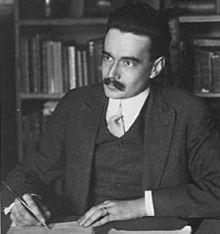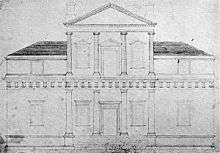Fiske Kimball
| Fiske Kimball | |
|---|---|
 Kimball, ca. 1915 | |
| Born |
Sidney Fiske Kimball December 8, 1888 Newton, Massachusetts |
| Died |
August 15, 1955 (aged 66) Munich, Germany |
| Nationality | American |
| Alma mater |
Harvard University University of Michigan |
| Occupation | Architect |
Sidney Fiske Kimball (1888 – 1955) was an American architect, architectural historian and museum director. A pioneer in the field of architectural preservation in the United States, he played a leading part in the restoration of Monticello and Stratford Hall Plantation in Virginia.
Over his nearly-30-year tenure as director of the Philadelphia Museum of Art, he moved the museum into its current building and greatly expanded its collections.
Biography


Kimball was born in Newton, Massachusetts on December 8, 1888.
He was educated at Harvard University, where he took both his bachelor's and master's degrees in architecture. He then taught at the University of Illinois and the University of Michigan, receiving a Ph.D from the latter institution in 1915. In 1919, Kimball was appointed to head the newly formed department of art and architecture at the University of Virginia. While at the University of Virginia, he served as the supervising architect for Memorial Gymnasium (built in 1924),[1] and the McIntire Amphitheatre on grounds at the university.[2] He also designed the campus of Woodberry Forest School.[3]
In 1923, Kimball left the University of Virginia[4] to establish the Institute of Fine Arts at New York University. In 1925, he was appointed director of the Philadelphia Museum of Art, where he served until his retirement in January 1955. During his first year in Philadelphia, he lived in and restored the Mount Pleasant mansion.Kimball was a consultant on numerous other restoration projects, including Monticello, Gunston Hall, Stratford Hall, and Colonial Williamsburg.[3]
Kimball continued to work on projects in Virginia. Kimball designed his own home, Shack Mountain, in Albemarle County, Virginia, not from far Monticello.[5] Kimball used Jefferson's architectural principles as the basis of his design of Shack Mountain, short for Shackelford Mountain, the surname of a branch of Jefferson's descendants. Built in 1935-1936, Shack Mountain is a Jefferson-style pavilion, like Monticello, that is considered Kimball's masterpiece.[6][7]Shack Mountain was designated a National Historic Landmark in 1992.[8]
Fiske Kimball died in Munich, Germany, on August 14, 1955. He and his wife are buried at Monticello Memorial Gardens on Monticello Mountain, about a mile from Monticello.He is commemorated by the Fiske Kimball Fine Arts Library at the University of Virginia.
Marriage
Kimball married, in June 1913, Marie Christina Goebel (1889–1955), the half Dutch, half German daughter of Julius Goebel, a professor of Germanic languages at the University of Illinois. She eventually was the recipient of two Guggenheim Fellowships and served as Monticello's first curator (1944–55). She also wrote a three-volume biography of Jefferson.[9]
Works
- Thomas Jefferson, architect, Original Designs in the Collection of Thomas Jefferson Coolidge, Junior, 1916
- A History of Architecture, 1918 (with George Harold Edgell )
- Domestic Architecture of the American Colonies and of the early Republic, 1922
- American Architecture, 1928
- Mr. Samuel McIntire, Carver : The architect of Salem, 1940
- The Creation of the Rococo, 1943
- Great Paintings in America: One Hundred and One Masterpieces in Color, 1948 (with Lionello Venturi)
See also
References
- ↑ "Memorial Gymnasium National Register Nomination" (PDF). Virginia Department of Historic Resources. Retrieved 13 June 2012.
- ↑ "Shack Mountain National Historic Landmark Nomination" (PDF). Virginia Department of Historic Resources. 1992. Retrieved 13 June 2012.
- 1 2 http://gis.hpa.state.il.us/pdfs/223512.pdf
- ↑ "Fiske Kimball: Master of the Diverse Arts". Exhibit. University of Virginia Library. Retrieved 16 June 2012.
- ↑ Fiske Kimball:Shack Mountain, lib.virginia.edu
- ↑ Calder Loth, The Virginia Landmarks Register, By Virginia Department of Historic Resources, University of Virginia Press, 1999 ISBN 0-8139-1862-6
- ↑ K. Edward Lay, The Architecture of Jefferson Country: Charlottesville and Albemarle County, University of Virginia Press, 2000
- ↑ "Fiske Kimball, Shack Mountain", University of Virginia library
- ↑ "Marie Kimball". The Thomas Jefferson Encyclopedia. Retrieved 2010-08-02.
Further reading
- Thomas Jefferson, Architect: Original Designs in the Collection of Thomas Jefferson Coolidge, Junior, Fiske Kimball, 1916
- A History of Architecture, Fiske Kimball and George Harold Edgell, Harper & Brothers, New York, 1918
- Domestic Architecture of the American Colonies and of the Early Republic, Fiske Kimball, Charles Scribner's Sons, New York, 1922
- George & Mary Roberts, Triumph on Fairmount: Fiske Kimball and the Philadelphia Museum of Art, (Lippincott, 1959).
External links
- 'Fiske Kimball', Thomas Jefferson's Monticello, monticello.org
- Fiske Kimball Papers, Philadelphia Museum of Art, Philadelphia, Pennsylvania
- 'Fiske Kimball: Culmination and Legacy', University of Virginia
| Cultural offices | ||
|---|---|---|
| Preceded by Langdon Warner |
Director of the Philadelphia Museum of Art 1925–1955 |
Succeeded by Henri Gabriel Marceau |